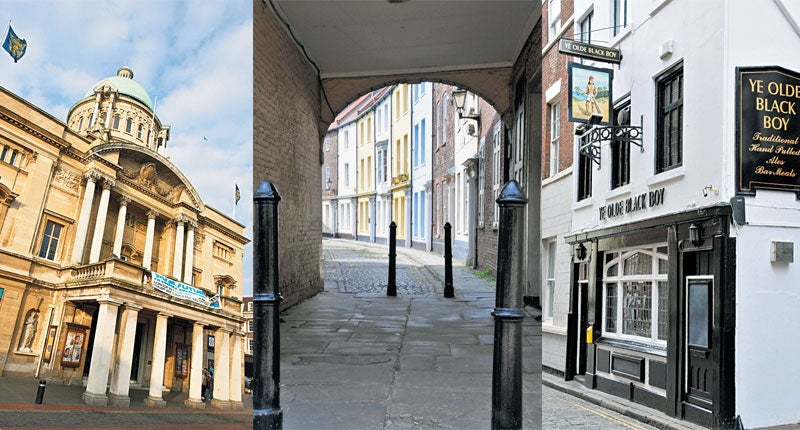Kingston-Upon-Hull: A city with poetry in motion
Philip Larkin’s legacy still echoes through Kingston-upon-Hull, says Jackie Hunter

As luck would have it, the first figure I spot when I get off the train at Hull’s Paragon station is Philip Larkin himself, mid-stride on the concourse.
With notebook clutched under one arm, overcoat flapping open and a hat swinging from his left hand, England’s favourite post-war poet and celebrated miserabilist looks surprisingly animated. Sculpted in bronze, this life-size statue was unveiled last December on the 25th anniversary of Larkin’s death. And it marks the starting point for a new walking trail of the poet’s personal demesne.
The Larkin Trail takes you around 25 locations marked by wall plaques in the city correctly known as Kingston-upon-Hull. This remote East Yorkshire city represented “the end of the line” for the solitary Larkin and he formed an affinity with it. Born in Coventry in 1922, Larkin worked as Hull’s University Librarian from 1955 until his death 30 years later.
He wrote his best-known works here, although typically he de-emphasised any emotional connection: “A place cannot produce good poems; it can only not prevent them and Hull is good at that. It neither impresses nor insists.”
Today I’m exploring Hull through Larkin’s discontented eyes, wondering what a man who shunned fame and declined the honour of Poet Laureate might have thought about this participatory memorial to his influence. On the statue’s plinth is engraved “That Whitsun, I was late getting away”. This is the first line from his 1964 poem “The Whitsun Weddings”, inspired by a bank-holiday train trip out of Hull. As Larkin’s likeness aims for the platform, I walk through a door that leads into the bar of the Station Hotel. Its atmosphere was lyricised by the poet in “Friday Night at the Royal Station Hotel”.
In a corner of the mahogany- panelled bar, where for Larkin “silence laid like carpet”, hangs a framed photograph of him with fellow poet John Betjeman, taken in 1973 at Hull City Hall – my next stop.
Leaving the bar via its front entrance on Ferensway, I walk to nearby Queen Victoria Square and City Hall. Larkin often listened to classical concerts broadcast from here and a piece of his own work – the words to the 1981 Humber Bridge cantata, “Bridge For Living” – was performed in it. The Hull Philharmonic orchestra continues to play here.
Onwards to Whitefriargate (“White-forgate”), conduit to the Old Town. Halfway up is Marks & Spencer, another mundane feature of the urban landscape that Larkin elevated to art in “The Large Cool Store” (1961). Intrigued by his library staff’s keenness to shop there, Larkin visited the store and wrote of “cheap clothes set out in simple sizes plainly”. Lines from the poem sit on a plaque between a ground floor lift and a rack of dismal cardigans in the same colours Larkin noted half a century ago: “Browns and greys, maroon and navy”.
I turn off Whitefriargate, towards Trinity Square and a statue of Hull’s other famous poet, Andrew Marvell (1621-78), who gave his name to the Marvell Press, which published Larkin. In a shop window, another Larkin Trail plaque quotes “For Hull has its own sudden elegancies” – which could apply to the exquisite Holy Trinity church and medieval Merchant Adventurers Hall in this tucked away space.
Beyond Fish Street, the landscape turns inelegant again as I dodge the thundering lorries of the A63. This was once Hull Corporation Pier – now gentrified and residential – from where boats ferried people across the Humber. Larkin was a regular passenger, though he travelled only for pleasure and never disembarked on the Lincolnshire side Back in the Old Town, I cut through the narrow 17th-century street called Land of Green Ginger, another stop on the Larkin Trail – he drank at several pubs in this atmospheric quarter. Among them is Ye Olde Black Boy, on the High Street. This historic pub is Hull’s oldest, licensed in 1724. It was here that the jazz fanatic and sometime critic Larkin gave a talk to Hull Jazz Record Society, in 1977. The nearby White Hart dates back to 1904 and boasts a listed interior with a curved Royal Doulton bar.
Larkin often called in for what he considered the best end to a day’s work, “a pint of gin and tonic”. No wonder he was morose… My last stop in the core of the city is Hull History Centre, where a rich archive of Larkin’s workbooks, letters, postcards, tapes and photographs can be examined.
Beyond the city, the trail visits 32 Pearson Park, where Larkin lived from 1956 to 1974. From his attic flat the poet had a clear view of the 22-acre Victorian park and its visitors, immortalised in the bleak “Toads Revisited”, with its “Palsied old step-takers, hare-eyed clerks” – published in his final collection, High Windows (1974).
On a suitably gloomy note, the trail also includes Spring Bank cemetery (“The most beautiful spot in Hull,” Larkin told Betjeman) and two hospitals: the Royal Infirmary and the Nuffield. Larkin died in the latter, holding a kind nurse’s hand and saying, “I am going to the inevitable.”
You have to head to the cemetery in nearby Cottingham to see Larkin’s grave, the headstone simply calling him “writer”. Finally, the true end of the line.
Travel essentials
Getting there
Details of trains to Hull’s Paragon station are available through national rail enquiries: 08457 484 950; nationalrail.co.uk. The main links are on Northern Rail from York, and on Hull Trains and East Coast from London King’s Cross via Doncaster.
Getting around
Pick up the free Larkin Trail guide at East Yorkshire Tourist Information Centres (01482 223 559; visithullandeastyorkshire.com) or download it from thelarkintrail.co.uk.
Subscribe to Independent Premium to bookmark this article
Want to bookmark your favourite articles and stories to read or reference later? Start your Independent Premium subscription today.

Join our commenting forum
Join thought-provoking conversations, follow other Independent readers and see their replies